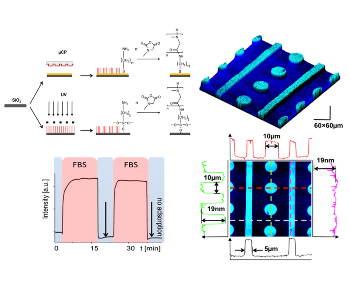Surfaces that are resistant to reversible or irreversible adsorption of proteins and to adherence of cells or bacteria are of great interest in many applications, such as biosensors, tissue engineering biotechnology and bioengineering. To prevent biomaterial adsorption, the surface should be highly hydrophilic and of zero net-charge. Moreover, hydrogen bond acceptor groups should be featured but no hydrogen bond donor groups.
A standard approach to alter the surface properties is to anchor polymers with the desired functionalities. This can generally be done by two methods – grafting-onto and grafting-from the surface. Grafting-onto refers to the method that polymers are being anchored onto the surface (top-down); grafting-from refers to the method of building up the materials from the surface (bottom-up). The latter method in particular leads to dense and stretched polymer chains that are base-anchored on the surfaces. These so-called polymer brushes are considered to be particularly useful for the preparation of non-fouling surfaces because of their perfect surface screening.
Polypeptoids are a class of biomimetic polymers which can meet the above mentioned criteria for non-fouling surface coatings. These polymers have been shown to be able to elicit excellent non-fouling properties, but until very recently, polypeptoid surfaces were only accessible by the grafting-onto approach. The development of the grafting-from approach gives access to dense polypeptoid brushes and enables the creation of surfaces with patterned antifouling features.
In new research, Jordan et al. have shown the synthesis of microstructured hydrophilic polypeptoid (polysarcosine) brushes by two different routes – microcontact printing (µ-CP) and photolithography, followed by surface initiated polymerization of N-substituted N-carboxyanhydrides. Using this approach, the resulting non-fouling coatings can be made thicker, denser and patterned with high structural fidelity, which may open up new possibilities in a wide array of applications.
Furthermore, since the polypeptoid brushes feature amines as terminal groups, they can be readily functionalized subsequently, as demonstrated with fluorescent dyes. Finally, it is shown that adhesion of serum proteins and human mesenchymal stem cells is very effectively prevented after polypeptoid brushes are grafted from gold surfaces.
In summary, this research introduces two new methods to obtain structured polysarcosine brushes, which exhibit excellent non-fouling properties and are of great interest for applications such as biosensors or tissue engineering.

















